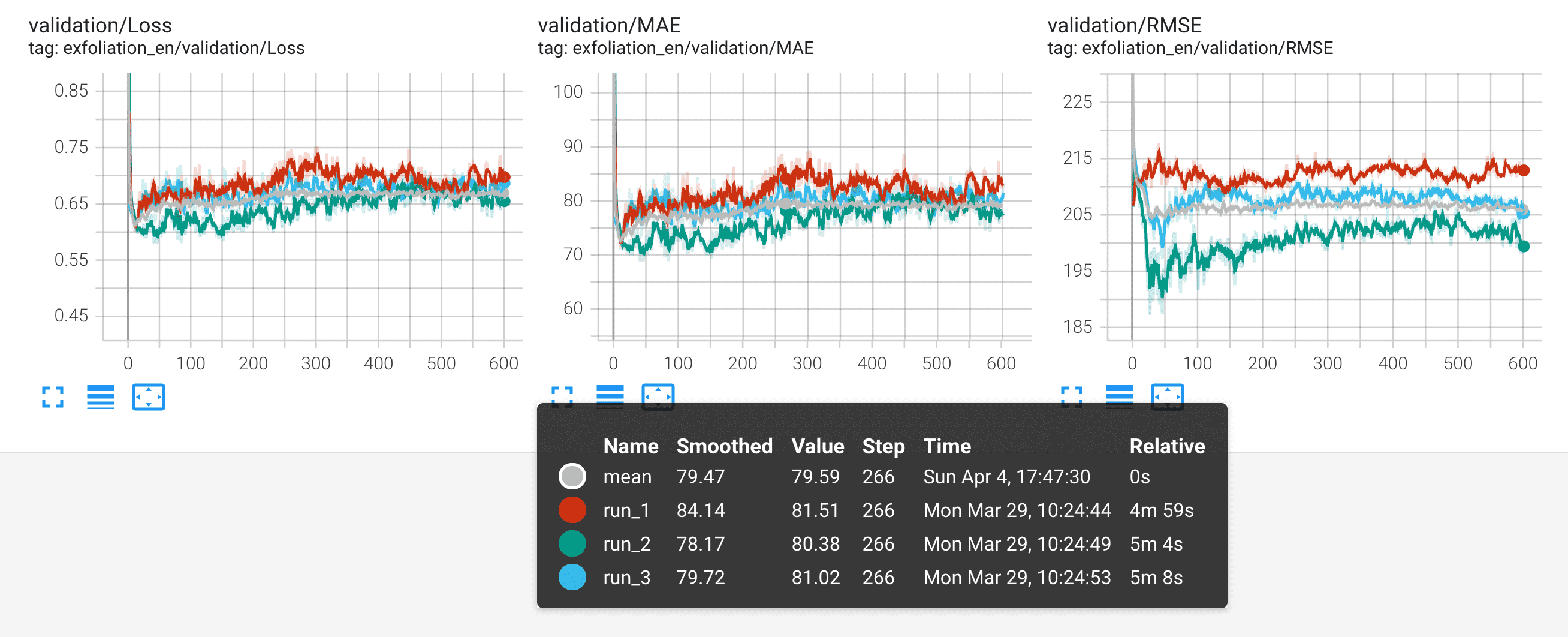Reduce multiple TensorBoard runs to new event (or CSV) files
Project description
This project was inspired by
tensorboard-aggregator(similar project built for TensorFlow rather than PyTorch) and this SO answer.
Compute reduced statistics (mean, std, min, max, median or any other numpy operation) of multiple TensorBoard runs matching a directory glob pattern. This can be used e.g. when training multiple identical models (such as deep ensembles) to reduce the noise in their loss/accuracy/error curves and establish statistical significance in performance improvements. The aggregation results can be saved to disk either as new TensorBoard event files or as CSV.
Requires PyTorch and TensorBoard. No TensorFlow installation required.
Installation
pip install tensorboard-reducer
Usage
CLI
tb-reducer -i 'glob-pattern/of-dirs-to-reduce*' -o output-dir -r mean,std,min,max
Note: By default, TensorBoard Reducer expects event files containing identical tags and equal number of steps for all scalars. If e.g. you trained one model for 300 epochs and another for 400 and/or added different sets of tags, see flags --lax-tags and --lax-tags to remove this restriction.
tb-reducer has the following flags:
-i/--indirs-glob(required): Glob pattern of the run directories to reduce. Remember to protect wildcards*with quotes to avoid shell expansion.-o/--outpath(required): File or directory where to save output on disk. Will save as a CSV file if path ends in '.csv' extension or else as TensorBoard run directories, one for each reduce op suffixed by the op's name, e.g.'outpath-mean','outpath-max', etc. If output format is CSV, a single file will be created with two-level header containing one column for each combination of tag and reduce operation. Tag names will be in top-level header, reduce op in second level.-r/--reduce-ops(optional, default:mean): Comma-separated names of numpy reduction ops (mean,std,min,max, ...). Each reduction is written to a separateoutpathsuffixed by its op name. E.g. ifoutpath='reduced-run', the mean reduction will be written to'reduced-run-mean'.-f/--overwrite(optional, default:False): Whether to overwrite existing output directories/CSV files.--lax-tags(optional, default:False): Allow different runs have to different sets of tags. In this mode, each tag reduction will run over as many runs as are available for a given tag, even if that's just one. Proceed with caution as not all tags will have the same statistics in downstream analysis.--lax-steps(optional, default:False): Allow tags across different runs to have unequal numbers of steps. In this mode, each reduction will only use as many steps as are available in the shortest run (same behavior aszip(short_list, long_list)).--handle-dup-steps(optional, default:None): How to handle duplicate values recorded for the same tag and step in a single run. One of'keep-first','keep-last','mean'.'keep-first/last'will keep the first/last occurrence of duplicate steps while 'mean' compute their mean. Default behavior is to raise an error on duplicate steps.--min-runs-per-step(optional, default:None): Minimum number of runs across which a given step must be recorded to be kept. Steps present across less runs are dropped. Only plays a role ifstrict_steps=False. Warning: Be aware that with this setting, you'll be reducing variable number of runs, however many recorded a value for a given step as long as there are at least--min-runs-per-step. In other words, the statistics of a reduction will change mid-run. Say you're plotting the mean of an error curve, the sample size of that mean will drop from, say, 10 down to 4 mid-plot if 4 of your models trained for longer than the rest. Be sure to remember when using this.
Note: Use pandas.read_csv("path/to/file.csv", header=[0, 1], index_col=0) to read CSV data back into a multi-index dataframe.
Python API
You can also import tensorboard_reducer into a Python script for more complex operations. A simple example that makes use of the full Python API (load_tb_events, reduce_events, write_csv, write_tb_events) to get you started:
from tensorboard_reducer import load_tb_events, reduce_events, write_csv, write_tb_events
in_dirs_glob = "glob_pattern/of_directories_to_reduce*"
out_dir = "path/to/output_dir"
out_csv = "path/to/out.csv"
overwrite = False
reduce_ops = ["mean", "min", "max"]
events_dict = load_tb_events(in_dirs_glob)
n_steps, n_events = list(events_dict.values())[0].shape
n_scalars = len(events_dict)
print(
f"Loaded {n_events} TensorBoard runs with {n_scalars} scalars and {n_steps} steps each"
)
for tag in events_dict.keys():
print(f" - {tag}")
reduced_events = reduce_events(events_dict, reduce_ops)
for op in reduce_ops:
print(f"Writing '{op}' reduction to '{out_dir}-{op}'")
write_tb_events(reduced_events, out_dir, overwrite)
write_csv(reduced_events, out_csv, overwrite)
Project details
Release history Release notifications | RSS feed
Download files
Download the file for your platform. If you're not sure which to choose, learn more about installing packages.
Source Distribution
Built Distribution
Hashes for tensorboard-reducer-0.2.3.tar.gz
| Algorithm | Hash digest | |
|---|---|---|
| SHA256 | b60d08443f0876d7ef529224782ef4d744b6721fb6c332e000b175a8aabd908a |
|
| MD5 | a8d3be9e75d3f9795e4baf8aff84afc5 |
|
| BLAKE2b-256 | 8e19f11e0fd8d595a44ff10b1cd1f059e4207048fc4cc62ecac3229776467834 |
Hashes for tensorboard_reducer-0.2.3-py2.py3-none-any.whl
| Algorithm | Hash digest | |
|---|---|---|
| SHA256 | df8017ce9ad66cc322d1e7696d8628ac0884817a1ff9501c2ad758c1aeef0de2 |
|
| MD5 | c812ba1c79336e1ab02e1eaa093de5af |
|
| BLAKE2b-256 | dc0f32abecb6ff9860cba3ff55c02c4112efed0e85c2499ea83d6ade3b3d5a1b |

















